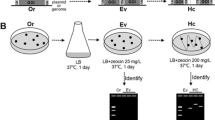Abstract
The amber mutation sites of 6 purR(am) mutants were determined by cloning and DNA sequencing. The results showed that the mutations were distributed at three different sites in PurR coding region, G721(→A), C933(→T) and C1155(→T), which respectively turn Trp-147, Gln-218 and Gln-292 of PurR into TAG terminal codon. To determine the effect of the three amino acid residues on regulatory function of PurR protein 5 different kinds of tRNA suppressor genes, Su3, Su4, Su6, Su7 and Su9 were used for creating the PurR protein variants with single amino acid substitution. The results indicated that Cys, Glu, Gly, His and Arg which substituted Trp-147 respectively all could not recover the regulation function of PurR. It confirmed that Trp-147 is a critical amino acid for the PurR function. Gln-292 substituted respectively by the same amino acids also could not recover the PurR function, demonstrating that Gln-292 is also an important amino acid residue in PurR.
Similar content being viewed by others
References
Zalkin, H., Nygaard, P.,Escherichia coli andSalmmella typhimurium Cellular and Molecular Biology, Washington D.C.: American Society for Microbiology, 1996, 561–579.
Maria, A. S., Choi, K. Y., Lu, F. et al., Mechanism of co-repressor mediated specific DNA binding by the purine repressor, Cell, 1995, 83: 147.
Choi, K. Y., Fu, L., Zalkin, H., Mutagenesis of amino acid residues required for binding of co-repressors to the purine repressor, J. Biol. Chem., 1993, 269: 24066.
Lu, F., Brennan, R. G., Zalkin, H.,Escherichia coli purine repressor: key residues for the allsteic transition between active and inactive conformation and for inter domain signaling, Biochemistry, 1998, 37: 15680.
Tang Hua, Qin Junchuan, Wang Aoquan, Regulation of purine biosynthetic genes expression inSalmonella typhimurium (VI)—Isolation and characterization of superrepressor mutants, Chinese Journal of Genetics (in Chinese), 1998, 25(2): 181.
Zhang Hesheng, Wang Aoquan, Regulation of purine biosynthetic genes expression inSalmonella typhimurium (X)—Isolation of purR(am) mutant and preliminary study of amino acid substitution, Chinese Journal of Genetics (in Chinese), 2000, 27(2): 170.
Davis, R. W., Roth, J. R., Advanced Bacteria Genetics, NY: Cold Spring Harbor Laboratory Press, 1984.
Miller, J. H., Experiments in Molecular Genetics, NY: Cold Spring Harbor Laboratory Press, 1972.
Sambrook, J., Fritsch, E. F., Maniatis, T., Molecular Cloning, A Laboratory Manual, NY: Cold Spring Harbor laboratory Press, 1989.
Katzif, S. D., Lu, C. D., Abdelal, A. T.,Salmonela typhimurium purine nucleotide synthesis repressor (purR), GenBank, Accession AF040636, 1998.
Weicket, M. J., Adhya, S., A family of bacteria regulators homologous to Gal and Lac repressors, J. Biol. Chem., 1992, 267: 15869.
Author information
Authors and Affiliations
Corresponding author
Rights and permissions
About this article
Cite this article
Zhang, H., Wang, A. Functional analysis of three amino acid residues of purR repressor, Trpl47, Gln-218 and Gln-292 inSalmonella typhimurium . Sci. China Ser. C.-Life Sci. 44, 184–191 (2001). https://doi.org/10.1007/BF02879324
Received:
Issue Date:
DOI: https://doi.org/10.1007/BF02879324




